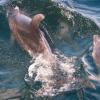Bayesian Depletion Model Estimates Of Spiny Lobster Abundance At Two Marine Protected Areas In Belize With Or Without In-Season Recruitment
In Belize, beginning in 2011 at Glover's Reef Marine Reserve, and in 2012 at Port Honduras Marine Reserve, fishers have been required to keep logbooks to document their catch and effort. A Bayesian depletion model including in-season recruitment was applied to the standardized catch per unit effort (cpue) of Caribbean spiny lobster (Panulirus argus) from the logbooks to estimate the abundance and fishing mortality of lobsters at both sites. Two alternative subsets of the cpue data were used to account for changes in targeting caused by the opening and closing of the queen conch (Strombus gigas) season. At Glover's Reef, a typical model estimated abundance ∼66–79 000 lobsters. Of these, ∼60–85% were present at the beginning of the season and the rest recruited into the fished population later in the season. The depletion model applied to data from the 2012 season at Port Honduras found an abundance of ∼12 000 lobsters, and in-season recruitment was not supported by the data. That in-season recruitment was present at Glover's Reef and not at Port Honduras may be explained by the fact that Glover's Reef has more unfished areas that could serve as a source of adult lobsters during the season. Glover's Reef has a larger no-take zone (20% of the reserve area, compared with 5% at Port Honduras), and it is surrounded by a deep wall reef where lobsters are found below the depth accessible to fishers. The models estimated a harvest fraction of ∼70% in both reserves.
Area of Interest: Belize
Year: 2014




